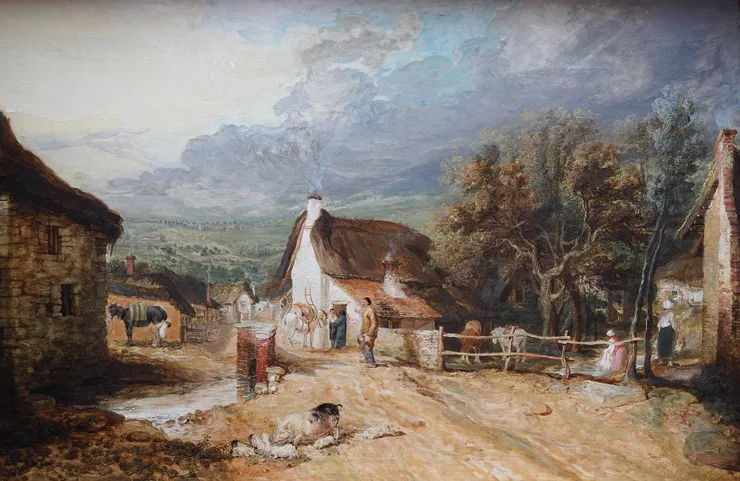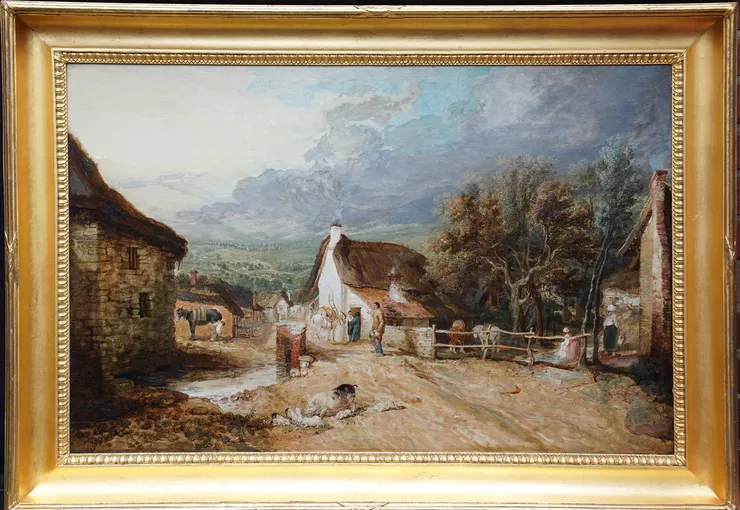James Ward (1769-1859)
| Artist Name | James Ward (1769-1859) |
|---|---|
| Title | Village Scene with Figures and Animals |
| Description | This stunning British Old Master exhibited pastoral oil on panel is by noted artist James Ward. Painted circa 1815 with superb provenance, it was exhibited posthumously at the Royal Academy London in 1885 whilst owned by Studley Castle. The painting is of a village setting with a number of villagers going about their activities outside their cottages including doing the laundry, shoeing a horse and passing the tine of day. He was a noted animal painter and there are numerous passages throughout the painting of animals. A sow and her piglets are in the foreground just before a bridge over a stream and the cottages follow the track beyond. There is a horse by the cottage. Behind the village are majestic hills and a Sublime sky with clouds rolling in. The painting is bathed in sunlight with fantastic fluid brushwork on the track and especially in the clouds. There is also great attention to detail such as the eves of the house on the near right, the stonework on the left and the leaves of the trees. This is a superb British Old Master oil painting with excellent provenance and is a fantastic example of Ward's work. Signed J WARD (in ligature, lower left). |
| Provenance | Charles Mansel Lewis (1845-1931) And by family descent Property from Stradey Castle, Wales Literature: C. Reginald Grundy, James Ward, R.A. His Life and Works (London, 1909), p.54, no. 858 Exhibited: London, Royal Academy, Winter Exhibition, 1885, no.33 Stradley Castle is a large Neo-Tudor house at Stradey one mile north west of Llanelli, Carmarthenshire was built by Edward Haycock of Shrewsbury from 1847 to 1855 for the solicitor David Lewis. His family had inherited the mineral rich estate which once included virtually all of the present day town of Llanelli from the Mansel family in 1808. His son Charles William Mansel Lewis (1845-1931), a distinguished amateur painter, aggrandized the interior and added a massive tower and link in the 1870s containing his studio.Charles William Mansel Lewis, a regular exhibitor at the Royal Academy knew many British contemporary artists including Briton Riviere and Sir Edwin Landseer but was particularly friendly with Sir Hubert von Herkomer (1849-1914) the society portraitist and social realist painter who painted his family and with whom he travelled on sketching tours in North Wales. Mansel Lewis was a promoter of art in Wales and the Welsh Eisteddfod for which he commissioned Herkomer to design some of the regalia. Mansel Lewis also was a great collector of pictures by contemporary and earlier artists and the lots in this sale were almost certainly purchased by him for his home Stradey Castle |
| Medium | Oil on Panel |
| Size | 45 x 30 inches |
| Frame | Housed in a 23 carat gilt frame 52 inches by 37 inches and in excellent condition. |
| Condition | Good condition. |
| Biography | James Ward RA (23 October 1769 – 17 November 1859) was an English painter, particularly of animals, and an engraver. Born in London to James Ward and Rachael Goldsmith, and younger brother of William Ward the engraver, James Ward was influenced by many people, but his career is conventionally divided into two periods: until 1803, his single greatest influence was his brother in law George Morland; from that time, it was Rubens. From 1810 or so onward, Ward specialised in painting horses within landscapes; slightly later, he turned to very large-scale landscapes, of which Gordale Scar (Tate, London), completed in 1814 or 1815 and depicting Gordale Scar (Yorkshire) as an example of the sublime, is considered his masterpiece and a masterpiece of English Romantic painting. Ward devoted much of the period 1815–21 to the painting of a gigantic work titled Allegory of Waterloo (now lost); this neither was much praised nor brought in the revenue Ward had hoped for. The experience may have embittered him, and the deaths of his first wife and a daughter were among other tragedies. Like many artists of the time, Ward sought commissions from wealthy gentry of their favorite horses, their favorite hunting dogs or their children. One such family that Ward painted and drew repeatedly, and whom he counted among his friends, were the Levett family of Wynchnor Park, Staffordshire. One of Ward's best-known portraits was his Theophilus Levett hunting at Wychnor, Staffordshire of 1817. Another was Ward's 1811 painting entitled The Reverend Thomas Levett and his favourite dogs, cock-shooting. Ward also painted a group portrait of three Levett children — John, Theophilus and Frances Levett. (For the Levetts, see link to the Ward exhibit at the Yale Center for British Art.) James Ward was one of the outstanding artists of the day, his singular style and great skill set him above most of his contemporaries, markedly influencing the growth of British art. Regarded as one of the great animal painters of his time, James produced history paintings, portraits, landscapes and genre. He started off as an engraver, trained by William, who later engraved much of his work. The partnership of William and James Ward produced the best that English art had to offer, their great technical skill and artistry having led to images that reflect the grace and charm of the era. He was admitted for membership into the Royal Academy in 1811. One of Ward's best-known paintings, The Deer Stealer, was commissioned in 1823 for the sum of 500 guineas by Ward's patron Theophilus Levett. When the work was finished, Levett pronounced himself delighted with the results, and consequently raised the remuneration to 600 guineas. Subsequently, Ward was said to have been offered 1,000 guineas for the painting by 'a nobleman,' which he declined. The painting now hangs at Tate in London. |
| Price | £120000 |

